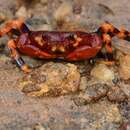en
names in breadcrumbs


Perbrinckia is a genus of freshwater crabs of the family Gecarcinucidae that is endemic to Sri Lanka,[1] named after Per Brinck. Its natural habitats are subtropical or tropical moist lowland forests, subtropical or tropical swamps, and rivers. It contains 14 species,[2] most of which are included on the IUCN Red List as critically endangered species (CR) or vulnerable species (VU) because they are threatened by habitat loss; only one species is of least concern (LC).
Perbrinckia is a genus of freshwater crabs of the family Gecarcinucidae that is endemic to Sri Lanka, named after Per Brinck. Its natural habitats are subtropical or tropical moist lowland forests, subtropical or tropical swamps, and rivers. It contains 14 species, most of which are included on the IUCN Red List as critically endangered species (CR) or vulnerable species (VU) because they are threatened by habitat loss; only one species is of least concern (LC).